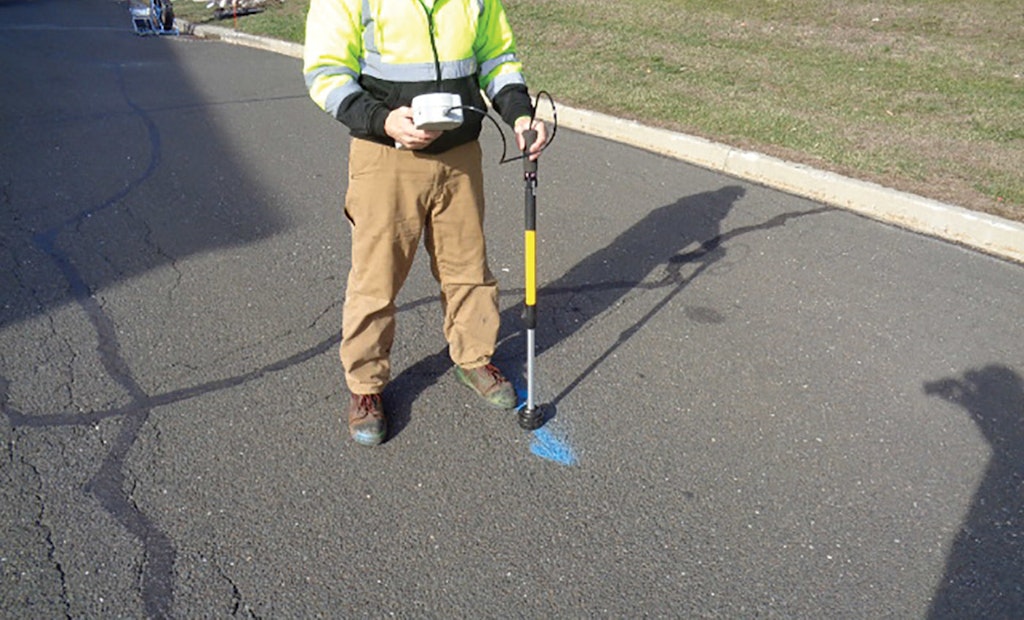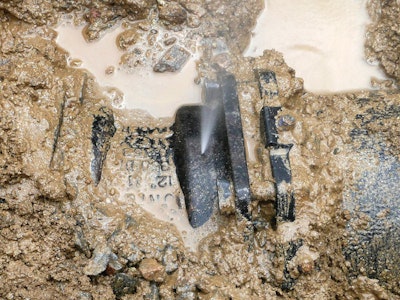
A technician runs a helium detector across a gas infused waterline to pinpoint the location of a leak.
Interested in Location/Detection?
Get Location/Detection articles, news and videos right in your inbox! Sign up now.
Location/Detection + Get AlertsPumping hydrogen into a pressurized pipe might sound like a recipe for the next Hindenburg disaster, but if done right, it can be an effective leak detection tool.
Tracer gas systems, which utilize either a hydrogen-nitrogen blend or pure helium, offer an uncommon solution that may be exactly the reliable option your company needs to step up its leak detection services.
While it has some potential limitations and isn’t the most convenient tool out there, it is precise and can detect smaller leaks than nearly any other method.
How it works
Similar to smoke testing, tracer gas systems work by adding gas to an isolated section of pipe and seeing what surfaces. Metaphorically speaking at least — the gas isn’t visible, so technicians walk along the length of the line with a gas detector.
“Essentially, you’re pumping helium right through the line, and wherever the leak is, it’ll come out of the pipe there and rise to the surface so we can detect it with a hand-held meter that picks up concentrations of the gas,” says Peter Viola, owner of Underground Surveying in Brookfield, Connecticut.
Because it is measured with a digital sensor, it eliminates some of the human error and ambiguity that naturally comes along with other methods.
The biggest drawback of tracer gas is that it requires the pipe in question be emptied and isolated, a time-consuming process that requires some plumbing know-how.
“Our guy who does it was a plumber for 10 years, so that definitely helps out; whereas, if somebody comes in without the plumbing experience, they’re going to be handicapped in what they can do,” Viola says. “It’s definitely something that if you’re just hiring guys off the street with minimal knowledge, they are going to have a little more trouble doing this particular service than teaching them acoustics, because it requires a little handiwork at times.”
On the other hand, if you have a plumber who can do the setup, the leak detection process itself can be done with less training than methods like acoustic.
“A lot of beginners find it a lot easier to use gas than listen for a leak,” says Brian Moss, owner of RJM Equipment Sales, a dealer of utility equipment.
There are systems that utilize 100% helium or a mix of 5% hydrogen and 95% nitrogen. The low percentage of hydrogen makes it noncombustible. Some systems can use either gas. The concentration of helium or hydrogen makes the gas easier to detect and the method more effective. But it’s also resource intensive. Some will mix their helium with air, but it is a balance between cost and effectiveness.
“Those are both lighter-than-air gases, so the molecules are going to work their way to the surface,” Moss says. “I haven’t compared them side by side, but I think they both work just as well, because while the hydrogen is diluted to 5%, the sensors will detect it to lower levels because it’s more reactive. Another important difference is that quite often suppliers don’t have helium available, and it’s more expensive. With hydrogen, you do have to plan ahead a little bit and have it mixed for you.”
Best uses
Most commonly used for residential and small commercial applications, it can become tricky for large systems because the section to be tested has to be cleared and pressurized. Commercial and municipal customers usually don’t like shutting off service, even briefly.
Despite requiring some setup, it can be a faster method than smoke testing, or even listening, depending on the experience of the technician. Viola says it usually takes his team about an hour to perform this service on standard residential jobs.
The systems aren’t bulky in and of themselves, but carrying the necessary amount of gas to job sites can be cumbersome. Both the initial investment and buying gas for each job make this a relatively costly option.
Locale can influence the decision, as it is best for areas with deeper lines and a prevalence of nonmetallic pipes.
“We find it’s a good tool to use when you have plastic pipes, because if you’re doing acoustics, you have to know exactly where the line is; but if you have a plastic pipe and you can’t get the exact location, sometimes that’s OK with tracer gas,” Viola says. “If you have a rough idea and you pump the gas in, it’s also going to show you where the line is, so it can actually help you locate the line when at times you can’t find it. So that’s just another little advantage to using it sometimes.”
Viola’s company started out with just acoustic leak detection but found that due to the atmospheric limitations and difficulty with inexperienced staff, it wasn’t reliable enough on its own.
“We had so many failures with acoustics early on — some of it was just learning the service ourselves, getting the ear, getting used to hearing the leaks,” he says. “But at the same time, we realized that acoustic definitely has its limitations, so we were just trying to reduce the limitations that we had, to give us a better chance of finding leaks. Often, where other methods fail, you end up using tracer gas and it works; it does the job.”







